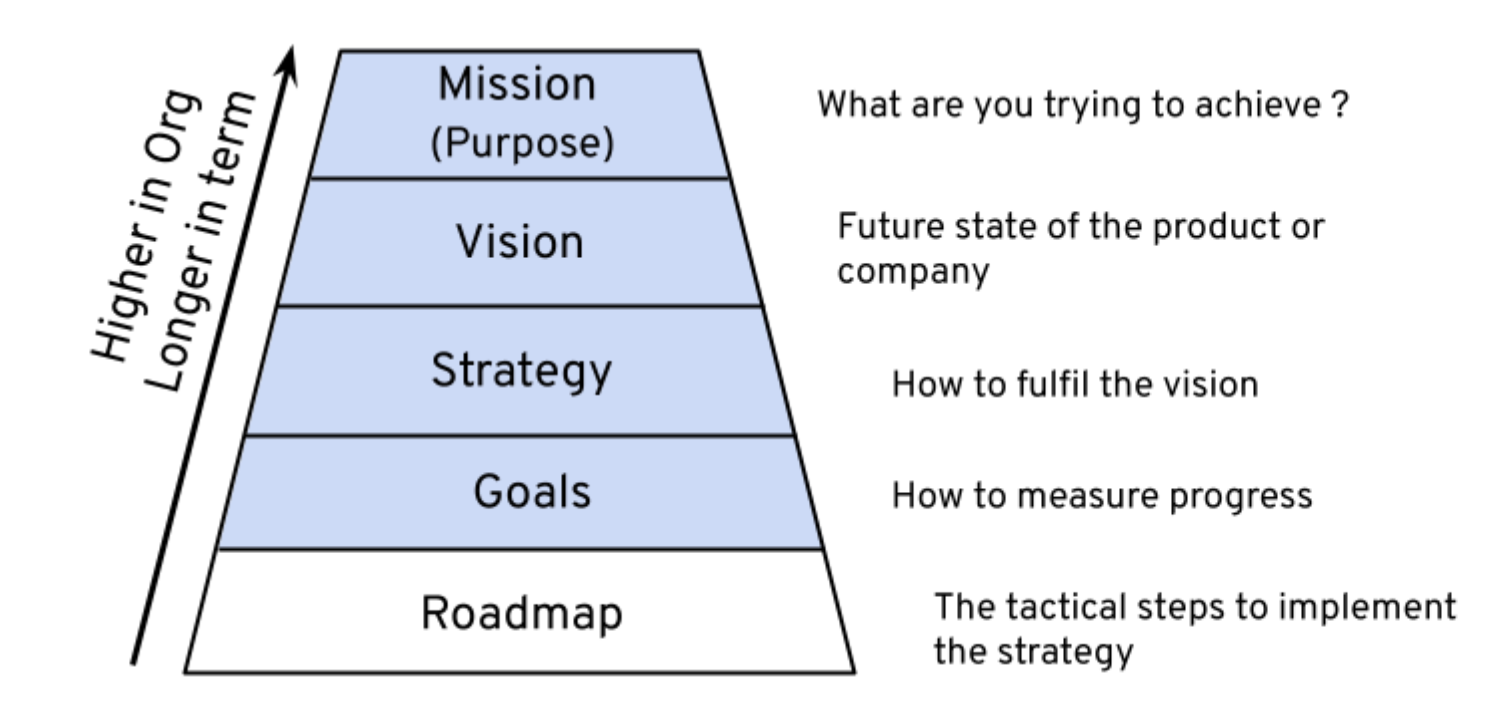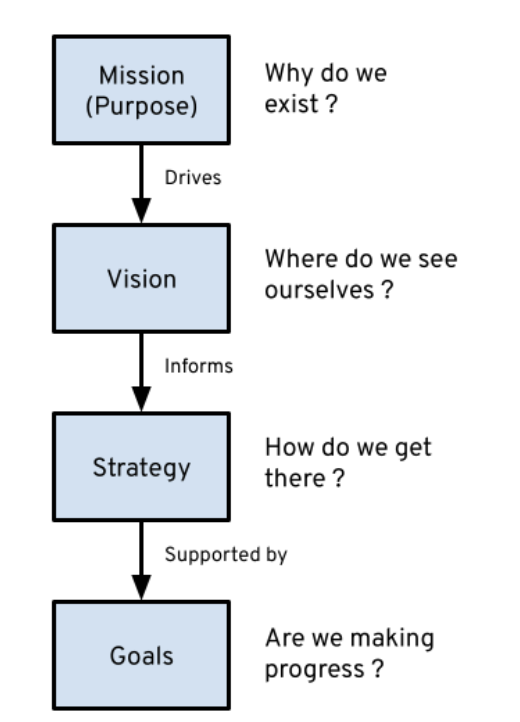I covered Roadmaps in a previous post, but product roadmaps cannot be created in isolation. Roadmaps must support your company or organization’s strategic direction captured in its Mission and Vision. I’ll outline these essential concepts and explain how they are connected to form a strategic planning framework.
First, clarifying the terms Vision and Mission is necessary. I’m using the term Mission to mean “the organization or product’s reason for being.” Mission is often used synonymously with Purpose, which I will use interchangeably. Occasionally, Mission is sometimes used as a synonym for Vision, but I find this confusing and will avoid doing this.
I use the term Vision to mean the organization or product’s future state – i.e., where the strategy will take the organization or product.

Mission
Your organization’s Why” is its core purpose and reason for its existence. It defines the fundamental value your brand contributes to your customers and users, the market, or the world and the positive impact it strives for. Think of it as the North Star that guides your decisions.
Your Mission should be captured and shared as a clear Mission Statement. Your Mission statement must be ambitious but also practical and achievable. It should also be durable and relatively static – it’s not uncommon for successful companies to have the same Mission for the organization’s lifetime.
It’s not uncommon for organizations to have an undeveloped or unclear Why – If you’re interested in developing or improving your organization’s Why, you could do much worse than start with Simon Synek’s Why, How, and What.
Vision
Your Vision is your organization’s “where” or aspirational future state. It paints a vivid picture of the market landscape when everything goes according to plan, considering future trends, threats from your competition, and opportunities. It serves as the guiding light for long-term investments and innovation efforts. Vision is about the future. Vision is aspirational and typically has a 3-5 year horizon.
Strategy
Your strategy is the actionable plan to achieve the vision. It translates the broad aspirations of the vision into concrete steps, considering resource constraints, market realities, and technical feasibility. It should be adaptable and responsive to changing market conditions and emerging technologies. In a larger organization, you will likely have a refinement of the corporate vision specific to the business or product, but the connection should be clear.
I present the hierarchy like this to represent the organizational altitude because it’s much more natural in larger organizations with multiple business units or products. It also helps you to think of the duration of these terms. At the top of the pyramid is Mission or Purpose – this could and should not change significantly over several years, decades, or even the organization’s lifetime. Vision is more likely to have a 3-5 year horizon. Strategy and Goals are linked to annual planning, and the Roadmap gets down to specific months, quarters, and year halves.
Likewise, Mission, Vision, and Strategy are typically defined at the company level and cascade down to business units or products, which will refine Strategy and Objectives to focus on the elements they can deliver or support.
Goals
I’m a big fan of OKRs (Objectives and Key Results) as a way to define and manage the execution of strategic goals, and I have successfully used OKRs in large and small organizations. Well-written OKRs help your team or organization achieve focus, accountability, engagement, transparency, and visibility. If you’re unfamiliar with the ORK framework – there’s no better place to start than John Doerr’s 2018 Ted Talk. There are many other goal management frameworks, and the advice below is general enough for any method. The important thing is that strategy alone is not enough – execution of the strategy needs to be monitored and managed.
Objectives capture your strategic initiatives – i.e., what your business unit, team, or product must do to support the business strategy or higher-level Objectives. They need to be inspirational enough to motivate people but also attainable to some degree – i.e. successful attainment should be between 80 and 120%. Well-written objectives clarify what the organization should be working on. Objectives shouldn’t be used to track an organization’s ordinary/mundane operations – you should have other ways to track those things. OKRs are better for monitoring ambitious goals- i.e. to help you achieve extraordinary results.
“Without strategy, execution is aimless. Without execution, strategy is useless.”
― Morris Chang
Each objective must have one or more Key Results – how you measure progress and ensure you stay on track to meet your objectives. Each objective should have between 2 and 5 Key Results at a given organizational level.
OKRs should be part of your annual planning, with quarterly reviews and the potential to make changes at least biannually.
In larger organizations, OKRs cascade down the organization. Depending on the nature of your OKRs, you could define supporting objectives at each level in the organization or have objectives that apply to all levels and Key Results defined at different levels so the results contribute to the level above.
The Whole Picture
There is plenty of literature on crafting Vision Missions and strategy. I’m not going to go into any more detail in this post – but as a Product Manager – it’s essential to understand how the concepts are connected. More importantly – Visions, Strategy, Goals, and Roadmap must be clearly and unambiguously connected.

Summary
To summarize, the mission is about the present, the vision is about the future, the strategy is the plan to achieve the vision, and the goals are the objectives that capture your strategic initiatives. OKRs are a great way to define and manage the execution of these strategic goals.
A well-defined Mission, Vision, and Strategy with clearly aligned Objectives will ensure your organization has focus, clarity, and the inspiration to succeed.